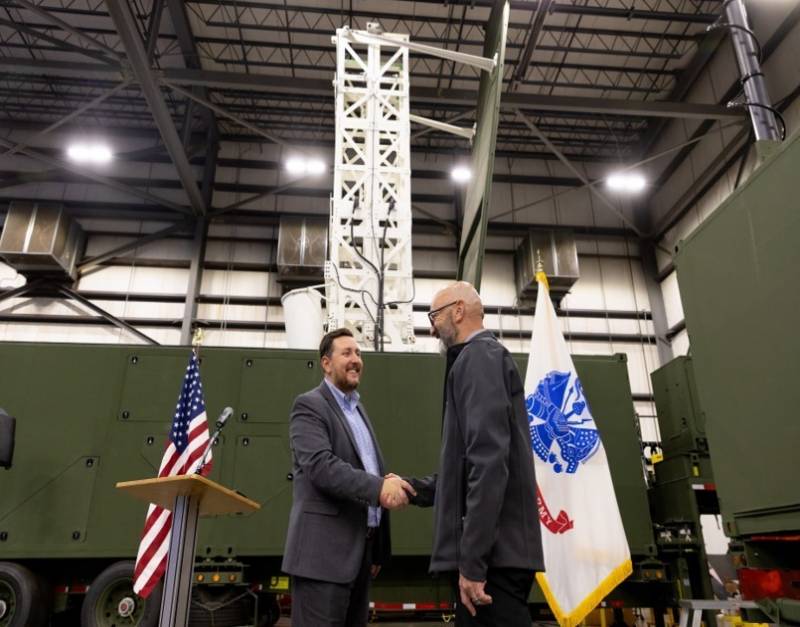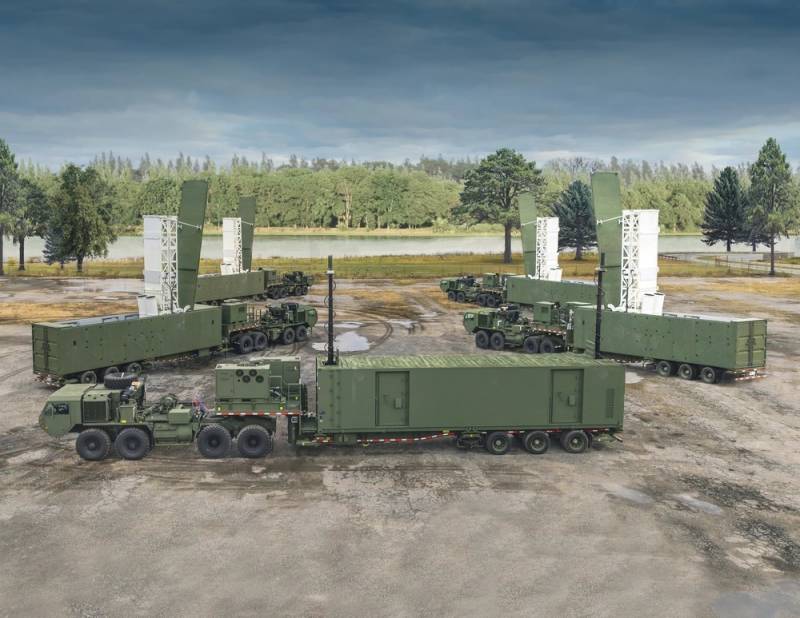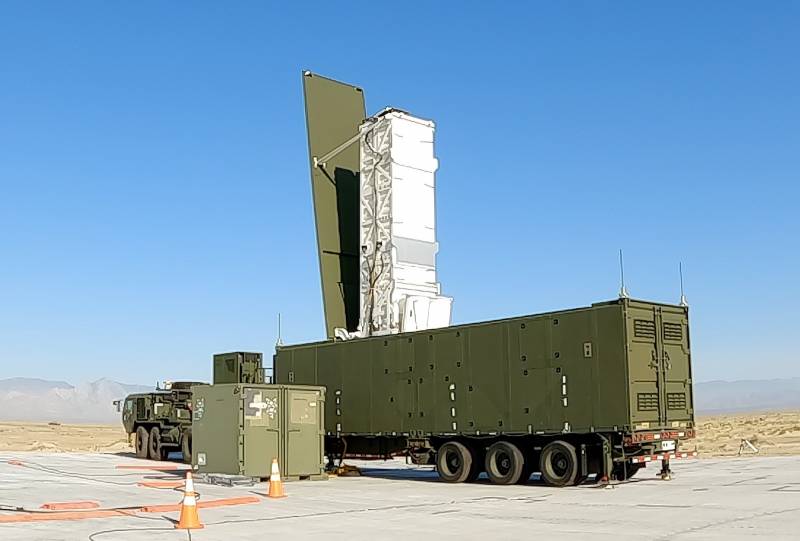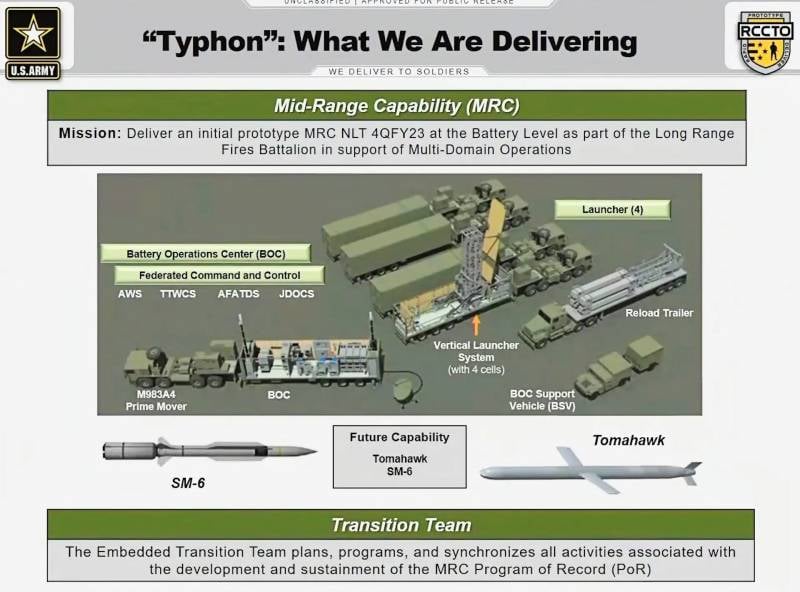Missile complex MRC Typhon confirmed its characteristics

Transfer of the first MRC complex to the customer, December 2022
In the interests of the US ground forces, a promising medium-range mobile missile system MRC Typhon is being created. A prototype of this type is already being tested and demonstrates its capabilities. In the last days of June, another test launch of the rocket took place, and according to its results, the complex was called fully combat-ready. Now the Pentagon and contractors can begin the next phase of the program.
Progress made
The Mid-Range Capability program (“Medium-Range Capabilities”) started at the end of the tenth years. On the basis of ready-made components, it was required to create a land-based missile system with enhanced combat characteristics. In November 2020, Lockheed Martin received a contract for the full development of such a complex, followed by the construction and testing of a prototype. All work was required to be completed by the end of calendar year 2023.
In October 2021, Lockheed Martin and the army revealed the appearance of the future complex for the first time. Also announced its official name - Typhon ("Typhon"). Shortly thereafter, the construction of the components of the first battery of the complex, intended for testing, began. It was handed over to the customer in early December 2022.
Over the next few weeks, the customer mastered the received equipment and, together with the contractor, prepared it for testing. At the beginning of 2023 (the exact date is not known), the experienced Typhoon performed its first rocket launch. This event used the SM-6 ammunition, a ship-based air defense anti-aircraft missile capable of operating as a quasi-ballistic missile. The complex and its rocket solved the task, and the tests were considered successful.
On June 28, the press service of the army reported that a new test had taken place the day before. This time, the MRC complex launched the Tomahawk cruise missile. Preparation for launch and rocket firing were carried out in a regular manner using a battery command post.

Typhon in the early stages of testing, January 2023 BOC command post in the foreground followed by launchers
Thus, over the past six months, the Typhon experimental complex has demonstrated its ability to use two types of ready-made missiles, and also confirmed the design characteristics. According to the US Army, the complex showed its full combat readiness. Now the missile force reinforcement program can move on to the next stage.
Plans for the future
Back in 2020-21 The Pentagon revealed the main plans for the creation and deployment of new ground-based missile systems, incl. promising MRC product. So, due to a reasonable reduction in the complexity of this project, it was planned to accelerate the development and appearance of finished products in combat units.
According to plans for 2021, the first Typhon battery should be tested in 2022-23. No later than September 2023, it will be deployed in the troops and put on experimental duty. Full service will begin later - by the beginning of Q2 FY2024. (by the beginning of the calendar year 2024) Thus, the US Army has six months to master new equipment.
Earlier, specialized media, citing sources in the Pentagon, reported that the ground forces needed at least five divisions of MRC complexes. Each such connection may include three batteries or more. Accordingly, in the medium term, Lockheed Martin will have to build and transfer to the troops at least 15 Typhon battery packs. In the future, it is possible to expand plans with an increase in the number of units and equipment in them.
It should be recalled that at present several promising systems with different characteristics and features are being developed for the American missile forces at once. In such a weapon system, the MRC product occupies a middle position - between operational-tactical missiles and strategic hypersonic systems. At the same time, it is considered a priority, because. combines a certain ease of development and construction with high combat performance.

June trials
On finished components
The purpose of the MRC project was to create a promising ground-to-ground missile system with enhanced combat capabilities. It was required to use the maximum number of ready-made units and components, incl. serial missiles. With the help of various types of ammunition, the future Typhon was supposed to solve the problems of operational-tactical complexes and medium-range systems.
The MRC Typhon battery kit includes the minimum set of tools necessary for self-combat work. It includes a unified command post for missile forces and artillery of the BOC type with a support vehicle, four launchers, as well as transport and loading systems.
The command post, launchers and transport units are built on three-axle semi-trailers and are moved using tractors of the HEMTT family. The BOC support vehicle is made on a lighter chassis and trailer. The Typhon battery can navigate on its own along predetermined routes. To perform shooting, it is necessary to place it in a prepared position, followed by deployment and connection of systems.
The MRC launcher is a rigid-hulled trailer carrying a lifting package for four transport and launch containers. The package is unified with the Mk 41 ship installation and can accept TPK with different types of missiles. Start is made from a vertical position.
At the moment, only two existing missiles are integrated into the Typhon complex, but in the future it is expected to expand the ammunition load with a corresponding change in combat capabilities. The MRC performs the functions of an operational-tactical missile system with the help of the ship's SM-6 missile defense system. As part of the Typhon, it operates in quasi-ballistic missile mode and cannot attack air targets. The flight range in this mode reaches 460 km. In the final section of the trajectory, targeting is provided with the help of an active radar seeker.

To hit targets at ranges of about 1800 km, it is proposed to use the Tomahawk cruise missile. This ammunition retains its configuration and must work according to standard algorithms.
In the future, MRC may receive other ammunition. Like the Tomahawk or SM-6, they are also borrowed from the Navy. At the same time, the further development of missile weapons fleet can affect Typhon as well. So, after 2024, a new version of the SM-6 rocket, Block IB, will be integrated into the complex. Due to the new solid-propellant engine, such a product will show a range of up to 700-740 km. In the future, the introduction of shipborne hypersonic missiles is not ruled out. Of course, if they are created and put into service.
New tasks
Thus, the Mid-Range Capability / Tyhon program is generally moving forward successfully. In a timely manner, its developers managed to create the required equipment and conduct the necessary tests. Based on the results of real launches, the customer called the new missile system ready for operation.
According to well-known plans, now the experienced Typhon will go into experimental military operation, the purpose of which is to additionally test equipment and gain experience by personnel. In addition, the developer company will have to prepare a production line for the production of serial complexes. The Pentagon needs at least 15 complexes, including a large number of various tools and products.
It should be recalled that the Pentagon planned to complete the development of several missile systems by the end of 2023 and put them on duty. In the case of the MRC Typhon, this problem is generally solved. However, the creation of a full-fledged combat-ready grouping of such complexes is still a matter of the distant future.
Information